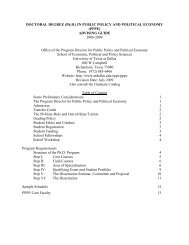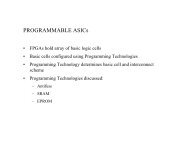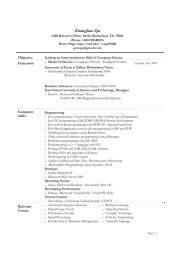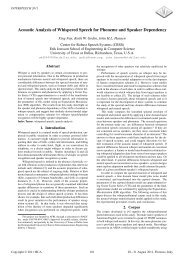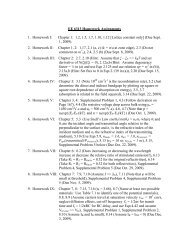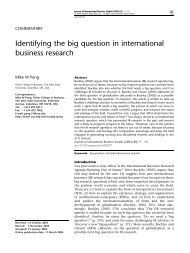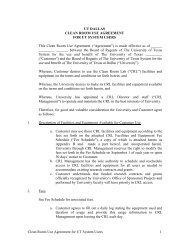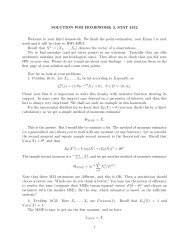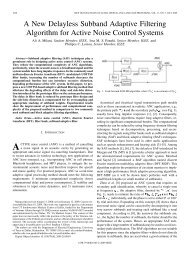Behind Intermediary Performance in Export Trade - The University of ...
Behind Intermediary Performance in Export Trade - The University of ...
Behind Intermediary Performance in Export Trade - The University of ...
Create successful ePaper yourself
Turn your PDF publications into a flip-book with our unique Google optimized e-Paper software.
survey, and was pooled together to compute<br />
net export sales marg<strong>in</strong> (export<br />
pr<strong>of</strong>its/export earn<strong>in</strong>gs) and per capita<br />
export sales (export earn<strong>in</strong>gs/number <strong>of</strong><br />
people).<br />
10. Among the 195 respondents, 78<br />
(40%) <strong>of</strong> them were born outside the<br />
United States. Two-thirds <strong>of</strong> the respondent<br />
firms had some foreign-born personnel.<br />
In 43 (22%) <strong>of</strong> these firms, the<br />
percentage <strong>of</strong> foreign-born personnel<br />
reached 75-100%. While some people<br />
were born but not raised abroad, our case<br />
studies and pretests suggested that key<br />
decision makers’ place <strong>of</strong> birth, <strong>in</strong> comb<strong>in</strong>ation<br />
with other factors listed <strong>in</strong> Table<br />
1, provides an important underly<strong>in</strong>g<br />
factor to form the construct <strong>of</strong> “export<br />
knowledge.”<br />
11. S<strong>in</strong>ce negotiation is an art that has<br />
to be learned by do<strong>in</strong>g (Lewicki, et al.,<br />
1994), <strong>in</strong>termediaries which are more<br />
frequently <strong>in</strong>volved <strong>in</strong> export negotiations<br />
are likely to be better negotiators.<br />
12. Although an export <strong>in</strong>termediary<br />
usually handles several different product<br />
l<strong>in</strong>es, the survey, based on our case<br />
studies and pretests, asked respondents<br />
to identify their typical products by referr<strong>in</strong>g<br />
to the product categories at the<br />
two-digit SIC level from which they derived<br />
their largest sales.<br />
13. None <strong>of</strong> the 17 studies reviewed by<br />
Madsen (1987) and the 11 studies reviewed<br />
by Leonidou and Katsikeas<br />
(1996) was able to employ LISREL.<br />
Work<strong>in</strong>g <strong>in</strong> previously unchartered territory,<br />
this exploratory study was primarily<br />
driven by our <strong>in</strong>terest <strong>in</strong> know<strong>in</strong>g<br />
what correlated with export <strong>in</strong>termediary<br />
performance, <strong>in</strong> the spirit <strong>of</strong> Beamish<br />
and colleagues (1999), Bilkey (1982), and<br />
Cavusgil and Zou (1994). <strong>The</strong>refore, similar<br />
to these studies, ours was also constra<strong>in</strong>ed<br />
by the lack <strong>of</strong> a longitud<strong>in</strong>al<br />
design which could flesh out cause-ef-<br />
MIKE W. PENG, ANNE S. YORK<br />
fect relationships (e.g., Shoham, 1998, p.<br />
68). However, as noted by Reviewer 1,<br />
this does represent a fruitful direction<br />
for future research.<br />
14. <strong>The</strong>se capabilities mitigate both<br />
the hazards <strong>of</strong> high transaction costs<br />
abroad (through search and negotiation<br />
services) and the hazards <strong>of</strong> high agency<br />
costs (through tak<strong>in</strong>g title and specialization<br />
<strong>in</strong> commodity products), thus lower<strong>in</strong>g<br />
the transaction and agency costs<br />
for their clients. Given that different<br />
countries are likely to present different<br />
transaction cost hazards (Henisz and<br />
Williamson, 1999), it is useful to divide<br />
countries <strong>in</strong>to groups <strong>of</strong> high and low<br />
hazards based on cultural distance,<br />
which was explored by Peng, Hill, and<br />
Wang (2000). In addition, it may also be<br />
useful to exam<strong>in</strong>e performance for those<br />
<strong>in</strong>termediaries specializ<strong>in</strong>g <strong>in</strong> different<br />
types <strong>of</strong> products, also attempted by<br />
Peng and colleagues (2000).<br />
REFERENCES<br />
Aaby, N. & S. Slater. 1989. Management<br />
Influences on <strong>Export</strong> <strong>Performance</strong>: A<br />
Review <strong>of</strong> the Empirical Literature,<br />
1978-88. International Market<strong>in</strong>g Review,<br />
6: 7-26.<br />
Anderson, E. & A. Coughlan. 1987. International<br />
Market<strong>in</strong>g and Expansion via<br />
Independent or Integrated Channels <strong>of</strong><br />
Distribution. Journal <strong>of</strong> Market<strong>in</strong>g, 51:<br />
71-82.<br />
Armstrong, J. & T. Overton. 1977. Estimat<strong>in</strong>g<br />
Nonresponse Bias <strong>in</strong> Mail Surveys.<br />
Journal <strong>of</strong> Market<strong>in</strong>g Research,<br />
14: 396-402.<br />
Aulakh, P. & M. Kotabe. 1997. Antecedents<br />
and <strong>Performance</strong> Implications <strong>of</strong><br />
Channel Integration <strong>in</strong> Foreign Markets.<br />
Journal <strong>of</strong> International Bus<strong>in</strong>ess<br />
Studies, 28: 145-175.<br />
VOL. 32, NO. 2,SECOND QUARTER, 2001 343



